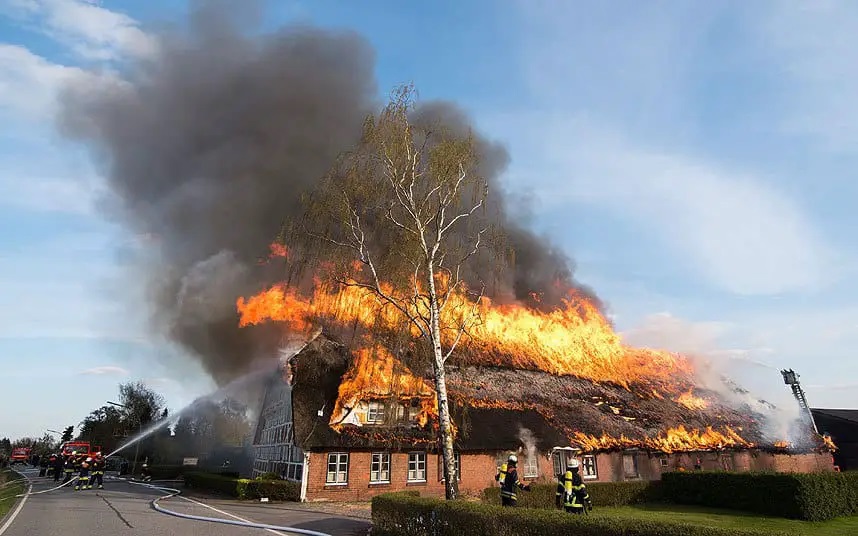
20 Mar Thatched Roof Fire Safety in UK
If you are fortunate enough to live underneath a lovely, traditional thatched roof or are thinking about purchasing a home with a thatched roof, you might be a little worried that your roof poses a greater fire risk than a typical roof. Buildings with thatched roofs are more costly to protect against fire damage, as you’ve probably already noticed, but that doesn’t mean they are more likely to catch fire. Instead, it all depends on how much damage your thatched roof may cause to the rest of the building if it does catch fire. The Thatch Information Centre warns: “if they do, the repercussions are frequently swift and dramatic,” statistically speaking, homes with thatched roofs are no more likely to catch fire than those with more conventional roofs. The Devon & Somerset Fire & Rescue Service claims thatch flames spread swiftly and are exceedingly difficult to extinguish: “Almost a quarter of thatched property fires we attended over the last six years saw the whole building damaged”. Even the National Society of Master Thatchers (NSMT) agrees that “thatch fires are disastrous,” not the least of which is the fact that they frequently lead to the loss of distinctive cultural structures.
Causes of Thatch Roof Fires
According to the NSMT, there are between 50 and 80 thatched properties that suffer a serious fire each year, almost all of which are older, pre-1960 structures, particularly listed properties with dense straw thatch. Most typically, a damaged, filthy, inadequately long, or malfunctioning chimney or flue is to blame for a thatch fire, especially if a woodburning stove is being used. This is more than simply a hunch. Burgoynes Consulting Scientists and Engineers’ well-known survey serves as support for it. The cause of the issue is thatch ignition caused by embers expelled from the flue or chimney.
Research has narrowed down further causes of fires on thatch roofs to include electrical issues, downlighters, intentional fires, and even lights used for cannabis growth in the loft! In extremely rare instances, thatch has also caught fire from flying embers from a campfire burning nearby.
Prevention of Fires in Thatched Roofs
Understanding the primary causes of thatch fires allows for the identification and implementation of preventive measures that lower the danger of fire. If you maintain your woodburner properly and apply common sense, you can keep your thatched home safe from fire without having to give up your woodburner.
- To keep sparks far from the thatch, make sure your chimney/flue is at least 1.8 metres above roof level and conforms to building regulations.
- Throughout the burning season, make sure to regularly sweep your chimney / flue.
- Follow the guidelines and recommendations provided by the manufacturer when using your woodburner. Burn only hardwood that has been dried in a kiln or that has a maximum moisture content of 20%.
- Avoid using paper and cardboard to start a fire; instead, use firelighters.
If a fire does start, remain calm and evacuate everyone in the home as soon as you can. Thatch fires are unpredictable and rapid, so don’t wait around to see where the smoke is coming from or attempt to put it out yourself.
Fire Alarms and Detectors for Thatched Houses
Thatch fires are problematic because they spread rapidly and burn ferociously, making early discovery essential.
Your thatched home should be equipped with sufficient and appropriate smoke and carbon monoxide alarms, and these should be regularly maintained and tested, just like any other building.
A heat monitoring and alarm system for the chimney area is a good idea in order to keep an eye on flue temperature fluctuations. It would be smart to install a fire suppression system on your property, that includes fire sprinklers, fire retardant sprays, and extinguishers, if you take fire safety seriously, as you should. All members of the household should be knowledgeable with the system and would need professional advice in this situation.
Also, there are several fire barriers and boards that have been especially created for thatch fire protection that may be installed over the rafters and underneath the thatch in order to contain a fire until the fire department can arrive. Discuss these items with Mike Bartlett Master Thatcher and find out which ones are best for your roof. You may relax and enjoy living under your charming thatched roof for many trouble-free decades if you follow the instructions of the local authorities, fire service, NSMT, and you’re local Master Thatcher, who are in S Fordingbridge, Salisbury, New Forest, Burley, Stockbridge, Ringwood, Lymington, Blandford, Romsey & Surrounding areas (Dorset, Wiltshire & Hampshire). is Mike Bartlett and sons.

